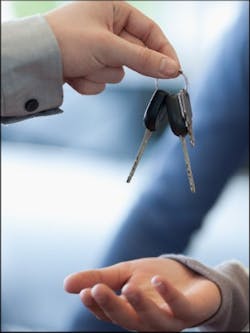One of the biggest points of stress for customers bringing their vehicles in for repair is a lack of transportation, says Vernie Menke, owner of the 9,600-squarefoot, $2-million-a year Menke’s Automotive Repair in Newburgh, Ind. Hoping to make the repair experience as painless as possible, Menke decided to create his own free loaner car program.
Eight years later, he and his staff of 13 now manage a fleet of 28 loaner vehicles, which he says have become integral to his business, which produces 340 repairs per month.
“It creates a lot of customer loyalty. You can market it, and it makes the customer’s decision a lot easier about where they’re going to go. It makes them think of you first. We run it in our TV commercials, our radio stuff, any marketing materials,” he says. “From the shop perspective, your shop can gain huge market share and a huge advantage over your competitors with no loaner programs. We’re the only independent in our area with a loaner car program.”
Although having loaner vehicles can be a helpful customer service tactic, there are several critical considerations that must be made when setting up a loaner fleet; namely, from a legal standpoint. Menke says that it is essential to create firewalls to avoid liability issues that could put your shop in peril.
“If you don’t, if something bad happens, [the customer] can come back and take everything you’ve got,” he says.
For Menke’s shop, that solution has been setting up his loaner fleet as a separate limited liability company (LLC) from the shop so the loaner fleet is seen as a separate legal entity. It’s a tactic that has worked well for the shop, he says, and has relieved a lot of worry over his large fleet.
Whether you have a loaner fleet of two or 28 vehicles like he does, Menke provides a checklist for setting up a second company for loaner cars that any shop—even ones with a much smaller loaner fleet—can follow.
STEP ONE:
Meet with your insurance agent, attorney and accountant. Menke says the first thing he did was get the important advisors in his business together to get any potential issues or problems out on the table and create a solution together. They discussed potential liability issues, how the insurance on the vehicle would be set up and how to protect the business should an accident occur.
“We realized there was a lot of liability stuff that was going to go on,” he says. “The attorney and also the insurance company, they want some firewalls here, too, to make sure that a customer won’t come back and sue them also.”
Menke says that the meet ing allowed all parties to mention any complications or considerations on their end, which allowed them to create a comprehensive solution with no loose ends.
STEP TWO:
Set up separate companies for the loaner fleet and auto repair business. What came out of that meeting was a suggestion from the attorney to set up three separate companies. The first company is the auto repair business itself (where the majority of the money and assets are located), while the second encompasses the property and the building, and the third is simply the loaner cars. All of the loaner cars are then licensed in the loaner car LLC. That way, if something bad happens with a wreck and the customer tries to sue, the only thing they can get is the loaner car LLC.
Registering each as an LLC distinguishes the companies as separate from the owner for liability purposes, but keeps taxes on the owner’s personal tax return. To form an LLC, which Menke says is fairly easy, you must register with the state and pay a statespecific filing fee of $388 per entity. Operating an LLC is also relatively easy, as there are few administrative requirements and it allows flexibility in changes to the ownership structure. Members are not held personally liable for debts or court judgments against the business and any court-issued penalties stop with business assets.
STEP THREE:
Make the companies functional. The companies cannot be ghost companies, Menke says. Meaning, they need to have a purpose and show there is money moving in and out.
“My accountant said, ‘If it ever goes to court, the judge can say that this is all bogus stuff,’” he says. “You have to make it look like all these companies have income.”
The way Menke has worked this at his shop is by creating agreements between all of the companies with his lawyer to show how the different companies interact and generate income. The auto repair company is, of course, generating income through the business. But every month, the auto repair company pays the property company a certain amount of money for renting or leasing the property. Then, the auto repair company pays the loaner car company $10 for every vehicle a customer borrows. Menke tracks that on his invoices and it gets zeroed out with the customer. But when it goes to the office, the auto repair company writes a check to the loaner car company once a month. Also in that contract, the company agrees to maintain those vehicles. The $10 is arbitrary, he says. The point is that there needs to be at least some money coming in and out.
STEP FOUR:
Carry proper insurance. You cannot carry full coverage insurance on these vehicles, Menke says, so basically the only choice is liability coverage. If something really bad happens, you’ve got to be in the position to throw the vehicle away. The way the insurance is set up in Menke’s loaner car form is that the customer’s insurance is always first. Meaning, if they total one of the loaner vehicles, thei r insurance company has to pay for it.
“We have had some accidents, especially in the winter,” he says. “Everything has worked out where the people’s insurance has taken care of it. We have yet to ever go back to our insurance company for any damages.”
That being said, Menke still has an excellent insurance company that covers these cars and he put $1 million of liability coverage with another $2 million umbrella on top of that, which he says runs him $800 a year per million.
“If they come back, they can get all of the loaner cars and they can get $3 million. Usually they’ ll stop right there,” he says. “When you’re suing, it all depends on if you can get enough money. Say you had only $500,000 on that company, if something bad happens and they say, we want a million and a half, then they’ll start coming after your other companies. But if you have enough insurance on this loaner car company, they’ ll stop right there.”
STEP FIVE:
Have an effective loaner vehicle form. Finally, Menke worked with his attorney to create a loaner vehicle form that each customer must fill out. Besides administrat ive questions, that form also includes legal information detailing how the insurance on the loaner vehicle is set up, that the shop is not liable and what will happen should an accident occur. In addition, customers must show proof of current insurance and a current driver’s license. Menke makes copies of both forms and keeps it attached to the signed loaner vehicle form.



